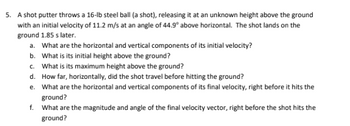5. A shot putter throws a 16-lb steel ball (a shot), releasing it at an unknown height above the ground with an initial velocity of 11.2 m/s at an angle of 44.9° above horizontal. The shot lands on the ground 1.85 s later. a. What are the horizontal and vertical components of its initial velocity? b. What is its initial height above the ground? c. What is its maximum height above the ground? d. How far, horizontally, did the shot travel before hitting the ground? e. What are the horizontal and vertical components of its final velocity, right before it hits the ground? f. What are the magnitude and angle of the final velocity vector, right before the shot hits the ground?
5. A shot putter throws a 16-lb steel ball (a shot), releasing it at an unknown height above the ground with an initial velocity of 11.2 m/s at an angle of 44.9° above horizontal. The shot lands on the ground 1.85 s later. a. What are the horizontal and vertical components of its initial velocity? b. What is its initial height above the ground? c. What is its maximum height above the ground? d. How far, horizontally, did the shot travel before hitting the ground? e. What are the horizontal and vertical components of its final velocity, right before it hits the ground? f. What are the magnitude and angle of the final velocity vector, right before the shot hits the ground?
Physics for Scientists and Engineers: Foundations and Connections
1st Edition
ISBN:9781133939146
Author:Katz, Debora M.
Publisher:Katz, Debora M.
Chapter3: Vectors
Section: Chapter Questions
Problem 62PQ: A glider aircraft initially traveling due west at 85.0 km/h encounters a sudden gust of wind at 35.0...
Related questions
Concept explainers
Topic Video
Question

Transcribed Image Text:5. A shot putter throws a 16-lb steel ball (a shot), releasing it at an unknown height above the ground
with an initial velocity of 11.2 m/s at an angle of 44.9° above horizontal. The shot lands on the
ground 1.85 s later.
a. What are the horizontal and vertical components of its initial velocity?
b. What is its initial height above the ground?
c. What is its maximum height above the ground?
d. How far, horizontally, did the shot travel before hitting the ground?
e. What are the horizontal and vertical components of its final velocity, right before it hits the
ground?
f.
What are the magnitude and angle of the final velocity vector, right before the shot hits the
ground?
Expert Solution
This question has been solved!
Explore an expertly crafted, step-by-step solution for a thorough understanding of key concepts.
Step by step
Solved in 5 steps with 5 images

Follow-up Questions
Read through expert solutions to related follow-up questions below.
Follow-up Question
Please solve d, e , and f

Transcribed Image Text:5. A shot putter throws a 16-lb steel ball (a shot), releasing it at an unknown height above the ground
with an initial velocity of 11.2 m/s at an angle of 44.9° above horizontal. The shot lands on the
ground 1.85 s later.
a. What are the horizontal and vertical components of its initial velocity?
b. What is its initial height above the ground?
c. What is its maximum height above the ground?
d.
How far, horizontally, did the shot travel before hitting the ground?
e. What are the horizontal and vertical components of its final velocity, right before it hits the
ground?
f.
What are the magnitude and angle of the final velocity vector, right before the shot hits the
ground?
Solution
Knowledge Booster
Learn more about
Need a deep-dive on the concept behind this application? Look no further. Learn more about this topic, physics and related others by exploring similar questions and additional content below.Recommended textbooks for you

Physics for Scientists and Engineers: Foundations…
Physics
ISBN:
9781133939146
Author:
Katz, Debora M.
Publisher:
Cengage Learning

College Physics
Physics
ISBN:
9781285737027
Author:
Raymond A. Serway, Chris Vuille
Publisher:
Cengage Learning

Principles of Physics: A Calculus-Based Text
Physics
ISBN:
9781133104261
Author:
Raymond A. Serway, John W. Jewett
Publisher:
Cengage Learning

Physics for Scientists and Engineers: Foundations…
Physics
ISBN:
9781133939146
Author:
Katz, Debora M.
Publisher:
Cengage Learning

College Physics
Physics
ISBN:
9781285737027
Author:
Raymond A. Serway, Chris Vuille
Publisher:
Cengage Learning

Principles of Physics: A Calculus-Based Text
Physics
ISBN:
9781133104261
Author:
Raymond A. Serway, John W. Jewett
Publisher:
Cengage Learning

Physics for Scientists and Engineers, Technology …
Physics
ISBN:
9781305116399
Author:
Raymond A. Serway, John W. Jewett
Publisher:
Cengage Learning

Physics for Scientists and Engineers with Modern …
Physics
ISBN:
9781337553292
Author:
Raymond A. Serway, John W. Jewett
Publisher:
Cengage Learning

University Physics Volume 1
Physics
ISBN:
9781938168277
Author:
William Moebs, Samuel J. Ling, Jeff Sanny
Publisher:
OpenStax - Rice University